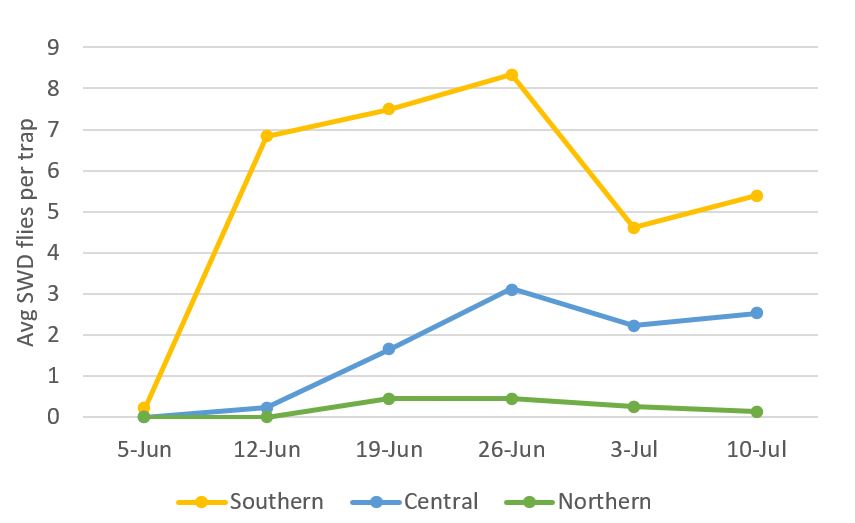Michigan spotted wing Drosophila update – July 14, 2020
Spotted wing Drosophila populations are active and growers should be protecting susceptible crops.

This year, Michigan State University Extension is monitoring for spotted wing Drosophila (SWD) activity in 17 counties (Figure 1) at over 90 sites that include vineyards, sweet and tart cherry orchards, and blueberry, raspberry and strawberry plantings. This report is the fourth of the season, and week six of our monitoring efforts.
As mentioned in earlier reports, weather is an important driver of SWD activity. This past week was a bit cooler and wetter across the state, but the number of SWD flies caught in traps remained relatively low (Figure 2). Since it takes eight to 10 days for SWD to complete their lifecycle from egg to adult, this apparent lag in population growth is likely due to the hot, dry weather that preceded this week. Rain events, humid weather, temperatures hovering at or below 90 degrees Fahrenheit, and wild hosts like honeysuckle ripening in field margins are all expected to result in higher numbers of SWD in the coming weeks.
The fact remains that every region (Figure 1) is still reporting greater than 20% of the traps catching SWD, and in some unprotected blocks of tart cherries, we are seeing the first fruit infestation by SWD larvae. This week’s sampling of commercial blueberry fields using the salt test found no evidence of larvae infesting the early ripening cultivars.

Berries
Early varieties of blueberries and summer raspberries in southern Michigan are becoming ripe enough to be susceptible and should be protected if they are ripening or ripe. Currants are being harvested in southern Michigan. For details on preparing for the expected rise in SWD in berry crops, tune in this week to the SWD Friday webinar series on July 17 from 12-1 p.m.
Cherries
Cherry harvest is finished in southern Michigan and is underway in other regions. This is the first season that we are exploring the use of fruit phenology to help predict when cherries may be at low, medium or high risk of infestation by SWD. The following model output, which we are working towards validating during the 2020 field season, is based on the assumption that cherry ripening will occur between 954 to 1170 growing degree days (GDD) base 39.2 F post bloom, and that SWD flies have been caught in the area. At this point in the season, the model predicts that cherries are at high risk of infestation everywhere they have yet to be harvested.
Grapes
Grapes are not at a susceptible stage anywhere in the state at this time. Details on how to manage SWD and other vinegar flies to minimize their role in sour rot in grapes will be presented during the SWD Friday webinar series on Aug. 14.
Managing SWD
Given how quickly this pest can reproduce and how devastating infestation can be, if your crop is at a susceptible stage and you have begun catching SWD flies in traps monitored on your farm, or if at least 20% of traps in your region have caught SWD flies in the past week, which they have in all regions we are monitoring, a cover spray of an insecticide that is rated excellent against this pest should be applied to protect fruit. Remember to rotate insecticide classes once you begin your spray program. Also, keep in mind that some classes of insecticides wash off after rain events or when using overhead irrigation more readily than others or will be less effective under high heat conditions (e.g., some pyrethroids).
Most of the crop-specific management guides have been updated for the 2020 season and are available as free downloadable PDFs, including a guide for home gardens. For more information on effective insecticides registered for use to control SWD, refer to the MSU Extension Michigan Fruit Management Guide (E154).
Sampling fruit for SWD infestation
You can determine how well your program is working by sampling fruit and using the salt test in the days prior to harvest. For details on the filter method described during the SWD Friday webinar series on July 10, check out this open-access article, “A Filter Method for Improved Monitoring of Drosophila suzukii (Diptera: Drosophilidae) Larvae in Fruit.”
Monitoring for SWD on your farm
The deli cup style trap is still the standard and can be used with either a commercial lure or a homemade yeast and sugar bait. For more information on how to monitor for SWD, refer to the crop management guides on the MSU Spotted Wing Drosophila website. For help with distinguishing SWD from all the other small flies that may be caught in SWD traps, refresh your identification skills with the Spotted Wing Drosophila Identification Guide from MSU.
Counties being monitored in 2020: Allegan, Berrien, Genesee, Ingham, Livingston, Macomb, and Van Buren in the south, Ionia, Kent, Mason, Oceana, and Ottawa in central Michigan, and Antrim, Benzie, Grand Traverse, Leelanau, and Manistee in the north.



 Print
Print Email
Email




